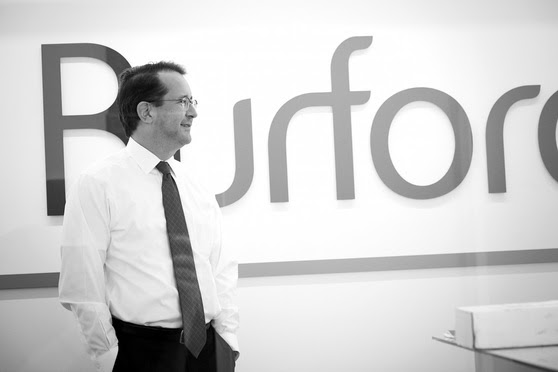The Law Firm Disrupted: What Does Litigation Finance Do for Big Law's Capital Cravings?
Burford Capital's big income and profit figures could give managing partners room to maneuver.
March 15, 2018 at 09:00 PM
7 minute read
In this week's Law Firm Disrupted, we take note of a big share price spike following Burford Capital's earnings report. And we ask: How can litigation funders help managing partners be more creative with capital?
I'm Roy Strom, the author of this humble newsletter/column, and I kindly beseech you to observe how I may achieve greater creativity in the realm of law firm business by clicking here: [email protected].

Wednesday was a good day to own stock in Burford Capital Ltd. After reporting what the firm's CEO called “across-the-board record-breaking numbers,” shares of the world's largest litigation funder jumped nearly 30 percent in intraday trading.
The shares ended the day up about 23 percent—gains that only a handful of publicly traded companies have matched on U.S. markets through midday Thursday. To use a timely analogy as March Madness tips off, Burford was the Big Dance's Cinderella story of the day.
Much of Burford's investors' gains could be premised on a story that the litigation financier tells about growing relationships inside Big Law firms. Those firms, the simple story goes, are having difficulty handling client cases under the traditional billable hour model. They are solving that problem through financing, a centuries-old business that has nevertheless failed to gain a foothold in the legal industry.
In the big picture, bringing finance to an entire industry is the kind of untapped market that could justify the kinds of money investors have piled into litigation funding in recent months. Burford isn't the only one with a war chest: A Financial Times story late last year estimated that something like £70 billion in capital was available for litigation finance. That article also notes that a tiny fraction—less than £1 billion—was actually put to use by U.K. funders in 2016.
In order to put all that good capital to good use, many in the industry think a change is needed. Change, it should be noted, is usually tricky in the legal world.
Some say funders will have to switch from financing one-off, big-money cases to backing a broader group of claims brought by a law firm or a corporate client. The industry calls this “portfolio financing,” and it is said to be cheaper for the ultimate client (in terms of the cut the funder gets) and provides more flexibility for how a law firm will use that money.
Portfolio financing is the kind of thing that Burford CEO Christopher Bogart was talking about when he told me Wednesday that litigation funding amounts to “a reinvention of the economics of the legal sector.”
It is hard to say for certain how many law firms have assented to reinvent their economics through financing a portfolio of cases. Burford has said it invested $100 million in a global law firm's commercial litigation business. Another large firm took $50 million in exchange for a cut of its arbitration cases.
The firm doing the most work for Burford—which has not been identified—is currently handling 14 percent of Burford's “investments,” the firm said in press release. Burford has 877 ongoing cases. Suffice it to say that Burford's relationship with this “global, enormous” law firm, as Bogart described it this week, is fairly important to both.
But will others follow? That's the tricky question in the legal industry.
Here is a good question for funders to answer if they want to attract more law firms to portfolio deals: What exactly can firms use this money for? Can it solve capital needs beyond smoothing payments for contingent cases?
Perhaps the best example of that comes from two-and-a-half years ago. That's when Burford partnered with Hausfeld, a U.S.-based plaintiffs firm that in recent years has been busy expanding into Europe, in a €30 million deal that was said to help the firm open an office in Berlin.
Burford's Bogart said Am Law 100 firms are using their relationship with funders in pitches to clients as a business development tool. But are they using it for things like hiring new partners?
“I don't know that. I'm not heavily involved in that side of the business,” Bogart said. “But if you have a law firm that is using our capital to grow, then by implication they're growing through recruiting people.”
If the litigation funding industry truly needs a broader shift toward portfolio financing, it would be well-suited to better and more frequently describe the benefits those deals provide to their ultimate clients: managing partners of large firms. That will help them change.
➤➤ Want to receive The Law Firm Disrupted as an email? Sign up here.
Roy's Reading Corner
On Change, or Lack Thereof: Above, I mentioned change being tricky in the legal industry. That is one of the main points made by Ken Grady in two posts titled, “Stagnation and the Legal Industry.” Part one lays out his argument that “transformative change has yet to arrive.” Part two provides his thoughts on what that chance could actually look like.
From Grady: “If we look carefully at the legal industry, we can see that not much has changed from 100 years ago even with these tweaks. What passes for innovation is, for the most part, unremarkable. In many cases, it represents a Rube Goldberg approach to the industry—complicated ways to accomplish what doesn't need to be done or could be done much easier without the software.”
On That Same Topic: Acritas Research Ltd. has some numbers to back up Grady's critique. In a survey of 2,000 in-house lawyers, Acritas states that 69 percent said they haven't seen their law firm or legal services provider “innovate” in the past 12 months. Their point seems to be that small, meaningful changes are better than more lofty ones.
Elizabeth Duffy, a vice president at Acritas U.S. Inc., said in a statement: “What is innovative to one client is normal practice to another. Our research clearly shows legal departments and their external legal service providers are at different stages of evolution. More basic levels of innovation can be made more impactful with new and different approaches, for example document management systems delivered through an app or warning notifications added to contract management systems.”
On AI, for Good Measure: Jackson Lewis said Thursday that it had partnered with ROSS Intelligence Inc. to provide an artificial intelligence solution for labor and employment work.
Jackson Lewis chairman Vincent Cino said in a statement: “Our relationship with ROSS Intelligence not only allows us to continue to provide excellent client service in the ever-changing business of law, but also ensures that as a firm we are fully leveraging the transformative artificial intelligence technology that is rapidly changing the knowledge economy.”
That's it for this week. Thanks for reading! As always, you can sign up here, and you can reach me with any comments here: [email protected].
This content has been archived. It is available through our partners, LexisNexis® and Bloomberg Law.
To view this content, please continue to their sites.
Not a Lexis Subscriber?
Subscribe Now
Not a Bloomberg Law Subscriber?
Subscribe Now
NOT FOR REPRINT
© 2025 ALM Global, LLC, All Rights Reserved. Request academic re-use from www.copyright.com. All other uses, submit a request to [email protected]. For more information visit Asset & Logo Licensing.
You Might Like
View All
Global Lawyer: Big Law Walks a Tightrope But Herbert Smith Freehills Refuses to Lose Its Footing
8 minute readTrending Stories
- 1OCR Issues 'Dear Colleagues' Letter Regarding AI in Medicine
- 2Corporate Litigator Joins BakerHostetler From Fish & Richardson
- 3E-Discovery Provider Casepoint Merges With Government Software Company OPEXUS
- 4How I Made Partner: 'Focus on Being the Best Advocate for Clients,' Says Lauren Reichardt of Cooley
- 5People in the News—Jan. 27, 2025—Barley Snyder
Who Got The Work
J. Brugh Lower of Gibbons has entered an appearance for industrial equipment supplier Devco Corporation in a pending trademark infringement lawsuit. The suit, accusing the defendant of selling knock-off Graco products, was filed Dec. 18 in New Jersey District Court by Rivkin Radler on behalf of Graco Inc. and Graco Minnesota. The case, assigned to U.S. District Judge Zahid N. Quraishi, is 3:24-cv-11294, Graco Inc. et al v. Devco Corporation.
Who Got The Work
Rebecca Maller-Stein and Kent A. Yalowitz of Arnold & Porter Kaye Scholer have entered their appearances for Hanaco Venture Capital and its executives, Lior Prosor and David Frankel, in a pending securities lawsuit. The action, filed on Dec. 24 in New York Southern District Court by Zell, Aron & Co. on behalf of Goldeneye Advisors, accuses the defendants of negligently and fraudulently managing the plaintiff's $1 million investment. The case, assigned to U.S. District Judge Vernon S. Broderick, is 1:24-cv-09918, Goldeneye Advisors, LLC v. Hanaco Venture Capital, Ltd. et al.
Who Got The Work
Attorneys from A&O Shearman has stepped in as defense counsel for Toronto-Dominion Bank and other defendants in a pending securities class action. The suit, filed Dec. 11 in New York Southern District Court by Bleichmar Fonti & Auld, accuses the defendants of concealing the bank's 'pervasive' deficiencies in regards to its compliance with the Bank Secrecy Act and the quality of its anti-money laundering controls. The case, assigned to U.S. District Judge Arun Subramanian, is 1:24-cv-09445, Gonzalez v. The Toronto-Dominion Bank et al.
Who Got The Work
Crown Castle International, a Pennsylvania company providing shared communications infrastructure, has turned to Luke D. Wolf of Gordon Rees Scully Mansukhani to fend off a pending breach-of-contract lawsuit. The court action, filed Nov. 25 in Michigan Eastern District Court by Hooper Hathaway PC on behalf of The Town Residences LLC, accuses Crown Castle of failing to transfer approximately $30,000 in utility payments from T-Mobile in breach of a roof-top lease and assignment agreement. The case, assigned to U.S. District Judge Susan K. Declercq, is 2:24-cv-13131, The Town Residences LLC v. T-Mobile US, Inc. et al.
Who Got The Work
Wilfred P. Coronato and Daniel M. Schwartz of McCarter & English have stepped in as defense counsel to Electrolux Home Products Inc. in a pending product liability lawsuit. The court action, filed Nov. 26 in New York Eastern District Court by Poulos Lopiccolo PC and Nagel Rice LLP on behalf of David Stern, alleges that the defendant's refrigerators’ drawers and shelving repeatedly break and fall apart within months after purchase. The case, assigned to U.S. District Judge Joan M. Azrack, is 2:24-cv-08204, Stern v. Electrolux Home Products, Inc.
Featured Firms
Law Offices of Gary Martin Hays & Associates, P.C.
(470) 294-1674
Law Offices of Mark E. Salomone
(857) 444-6468
Smith & Hassler
(713) 739-1250











